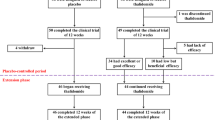Abstract
We evaluated the clinical responses to hydroxyurea (HU), adverse effects, and β-globin gene variants in a large series of β-thalassemic patients over a 13-year period in Iran. The patients (n = 232) were divided into two groups: transfusion-dependent β-thalassemia patients 2 years of age and older (n = 126; Group 1), and β-thalassemia intermedia (βTI) patients without any history of blood transfusion or with a long-interval transfusion (n = 106; Group 2). In Group 1, 86 patients became transfusion-free, and 25 patients needed 1–2 transfusions per year at the end of study. All except three patients in Group 2 were completely transfusion free with a significant increase in Hb level after 1 year compared to the baseline Hb value (P < 0.0001). We did not find a significant correlation of response to HU with XmnI polymorphism or IVS II-I (G > A) mutation (P > 0.05). In our study, HU at a dose of 8–15 mg/kg/day was effective in decreasing or effecting cessation of the need for regular blood transfusion, as well as in increasing Hb levels in β-thalassemia patients, without any major side effects. Hydroxyurea may thus represent a safe alternative to blood transfusion in transfusion-dependent β-thalassemia patients, or help to increase Hb level in untransfused βTI patients.


Similar content being viewed by others
References
Karimi M, Yavarian M, Afrasiabi A, Dehbozorgian J, Rachmilewitz E. Prevalence of beta-thalassemia trait and glucose-6-phosphate dehydrogenase deficiency in Iranian Jews. Arch Med Res. 2008;39:212–4.
Kattamis A. Treatment of thalassemia with hydroxyurea: an indispensable alternative therapy. J Pediatr Hematol Oncol. 2007;29:729–30.
Bradai M, Abad MT, Pissard S, Lamraoui F, Skopinski L, de Montalembert M. Hydroxyurea can eliminate transfusion requirements in children with severe beta-thalassemia. Blood. 2003;102:1529–30.
Hoppe C, Vichinsky E, Lewis B, Foote D, Styles L. Hydroxyurea and sodium phenylbutyrate therapy in thalassemia intermedia. Am J Hematol. 1999;62:221–7.
Karimi M. Hydroxyurea in the management of thalassemia intermedia. Hemoglobin. 2009;33(Suppl 1):S177–82.
Koren A, Levin C, Dgany O, Kransnov T, Elhasid R, Zalman L, et al. Response to hydroxyurea therapy in beta-thalassemia. Am J Hematol. 2008;83:366–70.
Yavarian M, Karimi M, Bakker E, Harteveld CL, Giordano PC. Response to hydroxyurea treatment in Iranian transfusion-dependent beta-thalassemia patients. Haematologica. 2004;89:1172–8.
Bradai M, Pissard S, Abad MT, Dechartres A, Ribeil JA, Landais P, et al. Decreased transfusion needs associated with hydroxyurea therapy in Algerian patients with thalassemia major or intermedia. Transfusion. 2007;47:1830–6.
Ehsani MA, Hedayati-Asl AA, Bagheri A, Zeinali S, Rashidi A. Hydroxyurea-induced hematological response in transfusion-independent beta-thalassemia intermedia: case series and review of literature. Pediatr Hematol Oncol. 2009;26:560–5.
Hajjar FM, Pearson HA. Pharmacologic treatment of thalassemia intermedia with hydroxyurea. J Pediatr. 1994;125:490–2.
Karimi M, Darzi H, Yavarian M. Hematologic and clinical responses of thalassemia intermedia patients to hydroxyurea during 6 years of therapy in Iran. J Pediatr Hematol Oncol. 2005;27:380–5.
Loukopoulos D, Voskaridou E, Stamoulakatou A, Papassotiriou Y, Kalotychou V, Loutradi A, et al. Hydroxyurea therapy in thalassemia. Ann N Y Acad Sci. 1998;850:120–8.
Zeng YT, Huang SZ, Ren ZR, Lu ZH, Zeng FY, Schechter AN, et al. Hydroxyurea therapy in beta-thalassaemia intermedia: improvement in haematological parameters due to enhanced beta-globin synthesis. Br J Haematol. 1995;90:557–63.
Alebouyeh M, Moussavi F, Haddad-Deylami H, Vossough P. Hydroxyurea in the treatment of major beta-thalassemia and importance of genetic screening. Ann Hematol. 2004;83:430–3.
Cario H, Wegener M, Debatin KM, Kohne E. Treatment with hydroxyurea in thalassemia intermedia with paravertebral pseudotumors of extramedullary hematopoiesis. Ann Hematol. 2002;81:478–82.
de Paula EV, Lima CS, Arruda VR, Alberto FL, Saad ST, Costa FF. Long-term hydroxyurea therapy in beta-thalassaemia patients. Eur J Haematol. 2003;70:151–5.
Huang SZ, Ren ZR, Chen MJ, Xu HP, Zeng YT, Rodgers GP, et al. Treatment of beta-thalassemia with hydroxyurea (HU)—effects of HU on globin gene expression. Sci China B. 1994;37:1350–9.
Kosaryan M, Vahidshahi K, Karami H, Ehteshami S. Effect of hydroxyurea on thalassemia major and thalassemia intermedia in Iranian patients. Pak J Med Sci. 2009;25:74–8.
Dixit A, Chatterjee TC, Mishra P, Choudhry DR, Mahapatra M, Tyagi S, et al. Hydroxyurea in thalassemia intermedia—a promising therapy. Ann Hematol. 2005;84:441–6.
Taher A, Sheikh-Taha M. Hydroxyurea use in Lebanese patients with beta-thalassemia intermedia. J Pediatr Hematol Oncol. 2006;28:107.
Karimi M, Cohan N, Moosavizadeh K, Falahi MJ, Haghpanah S. Adverse effects of hydroxyurea in beta-thalassemia intermedia patients: 10 years’ experience. Pediatr Hematol Oncol. 2010;27:205–11.
Zargari O, Kimyai-Asadi A, Jafroodi M. Cutaneous adverse reactions to hydroxyurea in patients with intermediate thalassemia. Pediatr Dermatol. 2004;21:633–5.
O’Branski EE, Ware RE, Prose NS, Kinney TR. Skin and nail changes in children with sickle cell anemia receiving hydroxyurea therapy. J Am Acad Dermatol. 2001;44:859–61.
Kennedy BJ, Smith LR, Goltz RW. Skin changes secondary to hydroxyurea therapy. Arch Dermatol. 1975;111:183–7.
de Montalembert M, Begue P, Bernaudin F, Thuret I, Bachir D, Micheau M. Preliminary report of a toxicity study of hydroxyurea in sickle cell disease. French Study Group on Sickle Cell Disease. Arch Dis Child. 1999;81:437–9.
Borgna-Pignatti C. Modern treatment of thalassaemia intermedia. Br J Haematol. 2007;138:291–304.
Saxon BR, Waye JS, Olivieri NF. Increase in hemoglobin concentration during therapy with hydroxyurea in Cooley’s anemia. Ann N Y Acad Sci. 1998;850:459–60.
Italia KY, Jijina FJ, Merchant R, Panjwani S, Nadkarni AH, Sawant PM, et al. Response to hydroxyurea in beta thalassemia major and intermedia: experience in western India. Clin Chim Acta. 2009;407:10–5.
Panigrahi I, Dixit A, Arora S, Kabra M, Mahapatra M, Choudhry VP, et al. Do alpha deletions influence hydroxyurea response in thalassemia intermedia? Hematology. 2005;10:61–3.
Acknowledgments
We thank the Vice Chancellery for Research of Shiraz University of Medical Sciences for approval support.
Conflict of interest
The authors declare that they have no conflict of interest.
Author information
Authors and Affiliations
Corresponding author
About this article
Cite this article
Karimi, M., Haghpanah, S., Farhadi, A. et al. Genotype–phenotype relationship of patients with β-thalassemia taking hydroxyurea: a 13-year experience in Iran. Int J Hematol 95, 51–56 (2012). https://doi.org/10.1007/s12185-011-0985-6
Received:
Revised:
Accepted:
Published:
Issue Date:
DOI: https://doi.org/10.1007/s12185-011-0985-6




